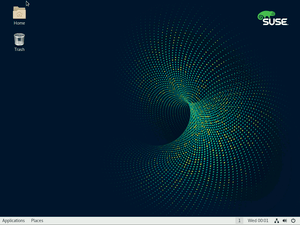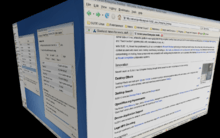SUSE Linux Enterprise Desktop
 SUSE Linux Enterprise Desktop 15 | |
| Developer | SUSE |
|---|---|
| OS family | Linux |
| Working state | Current |
| Source model | Open source |
| Latest release | 15 / June 25, 2018[1] |
| Marketing target | Enterprise computing (workstations, servers) |
| Available in | Multilingual |
| Update method | Zypper, YaST2 |
| Package manager | RPM Package Manager |
| Platforms | x86-64, PowerPC |
| Kernel type | Monolithic (Linux) |
| Userland | GNU |
| Default user interface | GNOME[2][3] |
| License | MIT License, GNU GPL and Various. |
| Official website |
www |
SUSE Linux Enterprise Desktop (SLED), formerly introduced as Novell Linux Desktop, is a Linux distribution supplied by SUSE and targeted at the business market.[4] It is targeted for desktops. New major versions are released at an interval of 24–36 months, while minor versions (called service packs) are released every 9–12 months. SUSE Linux Enterprise products, including SUSE Linux Enterprise Desktop, receive much more intense testing than the openSUSE community product, with the intention that only mature, stable versions of the included components will make it through to the released enterprise product.
The current version is SLED 15, which is developed from a common codebase with SUSE Linux Enterprise Server and other SUSE Linux Enterprise products. SLED includes Evolution 3.26 and many other popular open source packages such as Dia, TigerVNC, and lftp.
History
Novell Linux Desktop 9
Novell Linux Desktop 9 was originally released November 8, 2004[5], less than a year after Novell's acquisition of SUSE. There were a number of Service Packs (SP's) released for NLD 9. SP1 was released on February 11, 2005 and contained many updates. After that, SP2 was released on August 9, 2005, containing all the released updates and bugfixes since August 2004. SP3 was released on December 22, 2005.
NLD 9 was based on SUSE Linux 9.1 and offered a more conservative offering of desktop applications for businesses. Its desktop included common end user applications like Mozilla Firefox, OpenOffice.org. NLD also included software developed by Novell and its 2003 acquisition Ximian, such as the Red Carpet software management tool from Ximian and Novell's system management tool ZenWorks.[6]
SUSE Linux Enterprise Desktop 10
With SLED 10, Novell increased the focus on features for a broader range of corporate users by focusing on meeting the needs for basic office workers, positioning SLED as a competitor to Microsoft Windows. Basic office workers were defined in this context as users who need basic desktop functionality, including an office suite, a collaboration client, a web browser, and instant messaging. Novell attempts to meet these needs by concentrating on making these components very compatible with existing enterprise infrastructure, such as Microsoft Office data files, Microsoft Active Directory, and Microsoft Exchange Server or Novell GroupWise collaboration systems.
It also included the Beagle desktop search tool,[7] similar to Spotlight in Mac OS X v10.4. The Xgl+Compiz support enables a variety of advanced graphical effects in the user interface, such as "application tiling" (similar to Exposé). Other features include making it easier for Linux beginners to connect digital cameras to the computer and play audio files such as MP3s using Helix Banshee. The version of GNOME included this release was highly customized, and debuted the slab application menu on a one panel layout. SLED 10 was originally released June 17, 2006. The last service pack for SLED 10 was Service Pack 4, released April 15, 2011[8].
SUSE Linux Enterprise Desktop 11
SLED 11, based on openSUSE 11.1, was released March 24, 2009. It included an upgrade to GNOME and was the first release to ship KDE 4, with version 4.1.3. Several improvements were made to improve Microsoft Active Directory and Microsoft Exchange Server integration, and the Novell OpenOffice.org version was upgraded to version 3.0. SLED continued to include some proprietary components such as Adobe Flash, as well as open-source implementations of closed sourced plugins and runtimes such as Moonlight and Mono.[9]
Four service packs were released for SLED 11, with Service Pack 2 notably bringing BtrFS commercial support to the enterprise Linux market and including the snapper tool to manage BtrFS snapshots. The most current service pack, SP 4, was released July 17, 2015.
SUSE Linux Enterprise Desktop 12
On October 28, 2014, SUSE (now an independent business unit) released SLED 12 built on openSUSE 13.1. SLED 12 introduced several new technological upgrades, including systemd, GNOME 3, GRUB 2, plymouth, and the in-house built wicked wireless network manager. SLED 12 also included further stability and integration with BtrFS. With the transition to GNOME 3, the GNOME Classic Shell, the vanilla GNOME Shell, and a SLE Classic Shell with a design that more closely mimics the slab layout were included. KDE, the default desktop environment in openSUSE, and support for 32-bit x86 processors were dropped from the enterprise distribution. [10]
SLE 12 Service Pack 1 was the first to be the basis for openSUSE's more conservative Leap series, with openSUSE Leap 42.1 sharing the code with SLE 12 SP 1. Leap 42.2 and 42.3 were built from the same codebase as SLE 12 SP 2 and SLE SP 3 respectively. SLED 12's underlying base, SUSE Linux Enterprise Server 12, was the first version of SLE to be offered on the Microsoft Store to be run on the Windows Subsystem for Linux.[11]
SUSE Linux Enterprise Desktop 15
SLE skipped over versions 13 and 14 as openSUSE Leap and SLE realigned their versioning schemes at version 15. SLE 15 was released June 25, 2018 from the same codebase as openSUSE Leap 15.0. SLED 15 included major upgrades to GCC 7 and LTS kernel version 4.12, and made the Wayland implementation of GNOME the default. SLES and SLED can now also be installed from the same media. SLED 15 offers the same GNOME Desktop options as SLED 12.[12]
Basic Office Workers
Although it has grown a significant community of adherents, desktop Linux generally has not been adopted in the business world. Most distribution vendors usually concentrated on the server side of Linux, where the platform was rapidly becoming adopted. Desktop Linux continued to be focused on technical workstations (mostly CAD, EDA, and software engineering) and "fixed-function" systems (data entry workstations, kiosk, etc.)
SLED today includes a modified version of the GNOME Shell to include a more traditional layout for traditional desktop users. It also includes LibreOffice, Mozilla Firefox, and Evolution along with many standard GNOME utilities, such as GNOME Documents and GNOME Files.
Innovation
Novell's work on SUSE Linux Enterprise Desktop brought about several new open source features for Linux desktops.
Desktop Effects

Desktop Effects was built upon Xgl and Compiz to enable a variety of advanced graphical effects in the user interface, such as "application tiling" (similar to Exposé) and a spinning cube that interactively switches between desktops.
Desktop Search
SLED10 includes Desktop Search, built upon the Beagle project.
OpenOffice.org Improvements
The Novell OpenOffice.org team, led by Michael Meeks, managed to create reasonably solid support for VBA macros in Microsoft Excel documents, and a new spreadsheet feature called "Data Pilot" which offers compatibility with Microsoft Excel Pivot Tables .
Device and Application Support
SLED10 also includes the ability to connect digital cameras and iPods to a computer, and have an appropriate application automatically start when this happens.
Legal MP3 Encoding
Through a partnership with RealNetworks, Novell provides legal MP3 encoding (ripping) using the Helix Banshee.
Recognition
SUSE Linux Enterprise Desktop earned Novell wide acclaim for producing an extremely polished, mature, and fully functional Linux desktop. At LinuxWorld Expo 2006 in San Francisco, SUSE Linux Enterprise Desktop won both the Best of Show and Best Desktop Solution awards. InfoWorld subsequently gave it the Technology of the Year award as "Best Linux Desktop" in January 2007.[13]
People
Novell's effort on SUSE Linux Enterprise Desktop 10 was led by Nat Friedman, one of the two founders of Ximian. Nat was aided by a host of former Ximian and SUSE developers, with product manager Guy Lunardi and engineering manager Kelli Frame.
Derivatives
| Distribution | Desktop | Description |
|---|---|---|
| Tinysoft.com | GNOME and KDE | A lightweight enterprising OS distro for the Eastern FOSS and hardware vendors based off from NelsonOS.[14] |
Partnerships
HP offers business notebooks with SLED 11 preinstalled, under both its own brand and the Compaq brand.[15] Micro-Star International offers MSI Wind Netbooks with SLED 10 preinstalled.[16] Sun Microsystems previously licensed SLED as the basis of the Linux version of Java Desktop System.
See also
References
- ↑
- ↑ "The Definitive Guide to SUSE Linux Enterprise Server - Sander van Vugt - Google Books". Retrieved 2017-03-06.
- ↑ "DistroWatch.com: SUSE Linux Enterprise". Retrieved 2017-03-06.
- ↑ Peter Galli (2006). "Novell aims rebranded SUSE Linux 10 at enterprise desktops". eWeek. Archived from the original on 2008-07-25. Retrieved 2009-01-02.
- ↑ DistroWatch. "Distribution Release: Novell Linux Desktop 9 (DistroWatch.com News)". distrowatch.com. Retrieved 2018-07-26.
- ↑ "Novell Linux Desktop 9 Review | ZDNet". ZDNet. Retrieved 2018-07-26.
- ↑ Peter Galli (2005). "Novell Says Its Next Linux Desktop Will Surpass Windows". eWeek. Retrieved 2009-01-02.
- ↑ "Support | Availability of SLES10 SP4 for Novell Open Enterprise Server 2 (OES2) customers". www.novell.com. Retrieved 2018-07-25.
- ↑ Vaughan-Nichols, Steven J. "Novell's SUSE Linux Enterprise Desktop 11: A true Windows replacement". Computerworld. Retrieved 2018-07-26.
- ↑ Loschwitz, Martin. "SLE 12 » ADMIN Magazine". ADMIN Magazine. Retrieved 2018-07-26.
- ↑ "Get SUSE Linux Enterprise Server 12 - Microsoft Store". Microsoft Store. Retrieved 2018-07-26.
- ↑ "Release Notes | SUSE Linux Enterprise Desktop 15 GA". www.suse.com. Retrieved 2018-07-26.
- ↑ SUSE Linux Enterprise Desktop 10 Wins Best Linux Desktop Archived 2007-01-04 at the Wayback Machine.
- ↑ "Archived copy". Archived from the original on 2017-04-11. Retrieved 2017-06-22.
- ↑ HP E-Commerce Site
- ↑ Novell Extends Desktop Linux Leadership Through Pre-Load Agreement With Micro-Star International
Further reading
- Eckert, Jason (2007). SUSE Linux Enterprise Desktop Administration. Course Technology. ISBN 978-1-4283-2227-1.
- Habraken, Joe (2005). Novell Linux Desktop 9 Administrator's Handbook. Novell Press. ISBN 978-0-672-32790-2.
- Dulaney, Emmett (2005). Novell Linux Desktop 9 User's Handbook. Novell Press. ISBN 978-0-672-32729-2.
External links
- SUSE Linux Enterprise Desktop product page
- SUSE Linux Enterprise Desktop cool solutions – tips & tricks, guides, tools and other resources submitted by the SUSE Linux Enterprise community
- Example story of SLED 10 use in an educational environment
- Interview with Novell's Ted Haeger on NLD
- News about the next Novell Linux Desktop
- Novell aims rebranded SUSE Linux 10 at enterprise desktops - DesktopLinux.com news item about upcoming SUSE Linux Enterprise Desktop 10